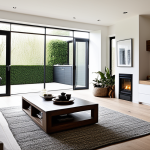Practical Impact of Sustainable Living in Residential Settings
Sustainable living in homes means designing and maintaining residences to minimize environmental footprint while promoting long-term well-being. Eco-friendly homes often incorporate energy-efficient technologies, renewable resources, and waste reduction measures tailored to meet daily needs responsibly.
The residential impact of sustainable living shows up in both immediate and lasting benefits. Homeowners see reduced utility bills thanks to efficient heating, cooling, and lighting systems. Over time, these energy savings accumulate, significantly lowering household expenses. Moreover, sustainable living enhances indoor air quality by using non-toxic materials and better ventilation, directly improving residents’ health.
Additional reading : What are the benefits of UK technology in healthcare automation?
Public interest in sustainable living is growing rapidly. More people adopt eco-friendly practices such as using sustainable materials and integrating renewable energy sources. Trends indicate a shift toward greener construction and home retrofitting, spurred by environmental awareness and economic incentives.
In sum, incorporating sustainable living into residential settings leads to measurable advantages like cost reductions, healthier environments, and a positive environmental impact. Embracing these practices transforms homes into models of responsibility without sacrificing comfort or convenience.
Also read : How Can You Transform Your Space with Simple UK Home Decor Trends?
Practical Impact of Sustainable Living in Residential Settings
Sustainable living in homes focuses on reducing environmental harm while enhancing quality of life. This approach means integrating eco-friendly homes with designs and technologies that conserve resources and promote efficiency. Key to sustainable living is the shift from traditional residential settings to those emphasizing renewable energy, efficient insulation, and minimal waste generation.
The residential impact is seen through both immediate and long-term effects. Immediately, households benefit from lowered energy consumption and decreased utility bills, often by adopting solar panels or energy-saving lighting. Over time, these improvements compound, making sustainable living financially rewarding and environmentally responsible.
Public interest in sustainable living has sparked broad adoption of green building techniques and retrofits that upgrade existing homes. The appeal lies not only in cost savings but also in creating healthier indoor environments free from harmful chemicals. People increasingly prefer materials certified as sustainable and choose practices that support a circular economy.
In summary, sustainable living transforms residential settings by blending environmental responsibility with practical daily advantages. Through conscious choices, eco-friendly homes serve as both sanctuaries for occupants and proactive contributors to global sustainability efforts.
Practical Impact of Sustainable Living in Residential Settings
Sustainable living, when applied to homes, means intentionally designing and managing residences to minimize environmental harm while enhancing everyday life. This approach prioritizes eco-friendly homes that utilize renewable energy, efficient insulation, and resource-saving technologies. The residential impact extends beyond energy consumption, influencing indoor air quality and waste reduction, fostering healthier and greener living spaces.
Immediate benefits include noticeable reductions in utility bills, often achieved through solar power installations or energy-efficient lighting and appliances. These savings motivate homeowners to embrace sustainable upgrades. Long-term advantages emerge as these efficiencies accumulate, significantly decreasing environmental footprints and increasing property value.
Public interest in sustainable living continues to climb as more people recognize its dual economic and ecological value. Trends reveal widespread adoption of green building practices and retrofitting older homes with sustainable materials. This shift encourages waste minimization and a commitment to circular economy principles within residential contexts.
Overall, sustainable living integrates environmental responsibility seamlessly into home life. By prioritizing eco-friendly homes and embracing conscious lifestyle changes, the residential impact becomes a catalyst for healthier living while actively supporting global sustainability goals.
Practical Impact of Sustainable Living in Residential Settings
Sustainable living in residential settings goes beyond basic eco-friendly measures; it encompasses a holistic approach that balances resource conservation with daily comfort. At its core, sustainable living involves designing homes that reduce energy use, water consumption, and waste production, thereby creating a smaller residential impact on the environment.
Immediate benefits of this lifestyle include noticeable energy savings through adopting solar panels, energy-efficient lighting, and improved insulation. These actions contribute to lower utility bills and fewer greenhouse gas emissions. The longer-term gains are even more significant, as homes built or retrofitted with sustainability in mind often boast increased property value and durability.
Public interest in eco-friendly homes is accelerating, driven by awareness of climate change and economic incentives. Trends highlight a shift towards using sustainable materials like bamboo, reclaimed wood, and low-VOC paints, all of which reduce pollutants inside the home while minimizing environmental harm. Additionally, many homeowners incorporate smart technologies for energy management, further optimizing their residential impact.
Together, these practices create healthier living environments and position sustainable living as a practical, increasingly popular choice—turning homes into active contributors to environmental stewardship without sacrificing convenience or style.
Practical Impact of Sustainable Living in Residential Settings
Sustainable living in residential settings is primarily about adopting lifestyle choices and home designs that reduce environmental strain while enhancing quality of life. This includes using eco-friendly homes that leverage renewable energy sources, superior insulation, and efficient appliances to lower energy consumption.
The residential impact manifests in both immediate and lasting benefits. Immediately, homeowners often experience reduced energy bills due to technologies such as solar panels and LED lighting. These savings provide quick financial relief and encourage further investment in eco-friendly upgrades. Over the long term, these homes generate less waste, consume fewer resources, and often maintain better indoor air quality by avoiding harmful materials.
Public interest continues to rise as awareness of climate change and sustainability grows. Many households are now adopting green technologies and materials, including recycled or sustainably sourced building components. Trends also point to an increased focus on designs that support circular economy principles by reducing waste and encouraging recycling, further amplifying the residential impact.
Ultimately, integrating sustainable living into homes creates practical and measurable advantages. Homeowners benefit from economic savings and improved well-being, while their choices contribute significantly to broader environmental preservation goals.
Practical Impact of Sustainable Living in Residential Settings
Sustainable living in residential settings focuses on consciously shaping eco-friendly homes to reduce environmental strain while enhancing daily life quality. This means adopting designs and technologies that minimize energy and resource consumption, leading to significant residential impact through decreased carbon emissions and waste generation.
Immediate benefits of sustainable living include reduced utility bills due to more efficient energy use, such as incorporating solar power or LED lighting. These savings motivate homeowners to continue eco-friendly practices, deepening the home’s residential impact by lowering operational costs and environmental footprints.
Long-term benefits arise from improved durability and property value, as sustainable homes often use materials selected for longevity and environmental compatibility. Increasingly, public interest drives widespread adoption of these practices, with more people choosing eco-friendly homes that integrate renewable energy, sustainable insulation, and low-impact construction techniques.
Trends show a combination of technological innovation and lifestyle shifts fueling this adoption. Homeowners contribute not only to personal financial gains but also to broader ecological preservation. Through thoughtful design and continual upgrades, sustainable living reshapes residential environments, making them hubs of responsible energy use and resource conservation.






